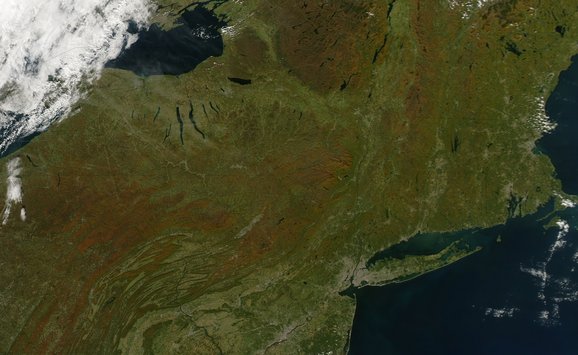ALTHOUGH THE Ninety-Fifth Congress resolved many long-standing parkland and wilderness issues—including Redwoods National Park and Mineral King in California, Boundary Waters Canoe Area in Minnesota, French Pete Wilderness in Oregon, and the Pine Barrens in New Jersey—it failed to enact legislation on the wildlands issue which eclipses all others, Alaska.
Introduced on the first day of Congress in 1977, the Alaska lands bill was under active consideration until the final hours of the session when efforts to negotiate compromise broke down. It was a classic land use confrontation.
When the Congress failed to act, it put in jeopardy the lands that had been temporarily reserved in 1971 by congressional action and by Secretary Morton’s administrative decisions. Thus, the scene was set in December for intervention by President Carter and Secretary of the Interior Andrus. Their actions earmarked about 95 million acres—nearly a fourth of the state’s area—for conservation, at least temporarily. But many issues were left to be resolved by legislation, thus the problem of establishing national parks, wildlife refuges, wild and scenic rivers, and wilderness areas in Alaska promises to be the dominant public lands issue in Congress this year.

Land status. Alaska is by far our largest state, more than twice the size of Texas. When it entered the Union in 1959, fewer than 1 million acres out of 375 million were in private ownership; the rest was federally owned. With statehood, Alaska was granted the right to select 105 million acres of unreserved public lands for state use over a twenty-five-year period. Thus, an area larger than California will pass from federal to state ownership, providing a land base for future economic development in the remote northern state by 1984.
In the last twenty years, land status in Alaska has been drastically affected by the discovery of oil and natural gas at Prudhoe Bay and the construction of the trans-Alaska pipeline. These events have set off a chain reaction. With oil revenues pouring into the state, plans for multimillion-(sometimes multibillion) dollar, state-financed development projects—dams, steel and aluminum mills, highways, petrochemical plants, railroads and pipelines—are receiving serious attention.
It is within this framework of economic growth and the rapid disposal of federal land that the movement to preserve large units of Alaska’s wildlands has gained momentum. Alaska contains three of the nation’s largest national park system units and approximately two-thirds of all acreage in the National Wildlife Refuge System, including the “crown jewel” of the refuge system: the Arctic National Wildlife Range. However, these conservation units did not begin to protect the nation’s treasury of natural wonders in Alaska.
Recognizing that there was much more to be done, Congress wrote section 17(d) (2) of the Alaska Native Claims Settlement Act of 1971 (ANCSA) directing the secretary of the interior “to withdraw from all forms of appropriation under the public land laws” up to 80 million acres in Alaska to be studied for addition to the National Park, Forest, Wildlife Refuge, and Wild and Scenic Rivers Systems. Lands withdrawn under this provision received protection only until December 18, 1978. In addition to withdrawing nearly 80 million acres of “national interest d-2 lands,” interior Secretary Morton withdrew almost all of the remaining unreserved public lands in Alaska under section 17(d) (1) of the ANCSA. These “public interest d-1 lands” are also withdrawn from appropriation under the public lands laws but not from mineral entry. (The primary purpose of the ANCSA was to settle aboriginal land claims in return for $1 billion and 44 million acres of federal land.)
Secretary Morton—on behalf of the Nixon administration—later recommended that Congress establish 83.5 million acres of conservation system units in Alaska in order to make permanent the actions he had taken. Conservationists urged that more acreage be included in conservation units and recommended stricter management of these units. Giving itself five years to act on the conservation system proposals, Congress took no action for three years after Morton’s recommendations. Not until January of 1977, when Rep. Morris K. Udall (D-Arizona) introduced H.R. 39, did Congress begin to consider seriously the national interest lands proposals. The deadline was less than two years away.

The legislative record. About a dozen different Alaska lands bills were introduced in the Ninety-Fifth Congress, and the legislation moved through Congress, becoming longer and more complex at each stage. While contrasting the acreages proposed for conservation in the various bills does not reveal differences among their management provisions, it can provide a meaningful yardstick for comparison. The principal bills were as follows:
- HOUSE BILL H.R. 39. As introduced by Representative Udall and eighty cosponsors, this bill proposed 115 million acres of new national parks, wildlife refuges, and wild and scenic rivers. Six areas totaling 6.6 million acres in Alaska’s two national forests were to become part of the National Wilderness Preservation System, as well as suitable lands in new and existing parks and refuges (approximately 140 million acres).
- ADMINISTRATION PROPOSAL. On September 15, 1977, Interior Secretary Cecil Andrus presented his 92-million-acre national interest lands bill to Congress. It called for 43 million acres of Wilderness System additions in parks and refuges, including wilderness in the existing Arctic National Wildlife Range, which is considered a potentially rich area for oil and gas deposits. In February 1978 the administration recommended 5.9 million acres in seven forest wilderness areas and 2.6 million acres for wilderness study status.
- H.R. 39 AS PASSED BY THE HOUSE. On May 19, 1978, the House voted 277 to 31 to pass a bill which would have placed 126 million acres in new conservation system units. The House bill provided for 65.5 million acres of designated wilderness, making severe cuts in the administration’s national forest wilderness proposal.
- H.R. 39 AS RECOMMENDED BY THE SENATE ENERGY COMMITTEE. With less than a week remaining in the congressional session, the Senate Energy and Natural Resources Committee reported its Alaska lands bill on October 9, 1978. The committee recommended 81 million acres of new national parks, wildlife refuges, and wild and scenic river systems; and it provided for 37 million acres of additions to the Wilderness System. Here acreage figures do not begin to tell the story of the changes wrought in committee. Owing to serious alterations in management provisions for the conservation units, this was the only one of four major bills which Sen. Ted Stevens (R.-Alaska) found “liveable” and the conservationist Alaska Coalition labeled “unacceptable.”

Principal issues. As in other matters of land preservation, the principal issues were protection of natural values on the one hand, and on the other, the pressure for development. Proponents of the Alaska lands bill argue that in Alaska the United States has its last opportunity to protect wildlands on a grand scale. Conservation in Alaska has been called “our last great first chance.” Since life is spread wide and thin in Alaska, protection of the natural environment and the wildlife it sustains demands that very large conservation units under one strict management regime be set aside.
Opponents of the legislation insist that the preservation of 100 million acres in Alaska will cost the nation dearly in untapped natural resources—oil, gas, metallic minerals, timber, agricultural lands. Most development, they say, is compatible with protection of the land, since development would occur within small discrete portions of these larger conservation units. The argument runs that we can have our cake and eat it too if we specify management classifications that allow regulated development.
Because extraordinarily high costs in Alaska forbid development of most natural resources, there is almost no likelihood in the foreseeable future that these resources which lie within the proposed conservation units can be developed. Therefore, the opponents of the Alaska lands bill have focused their objections on a few issues where the conflicts are immediate. Among the issues are:
- SUBSISTENCE. Many rural Alaskans, most of whom are Natives, live off the land—hunting, fishing, and gathering most of their livelihood on public lands. While the need to allow continued harvest by subsistence users in conservation units has not been an issue, the question of federal versus state versus local control of subsistence activity, particularly hunting, has resulted in extensive debate and controversy. A complex compromise is evolving.
- STATE LAND SELECTION. Because the state still has approximately 30 million acres of its land grant to select, the primary thrust of its opposition to the Alaska lands bill has derived from the claim that the state should be able to select its entire entitlement before Congress sets aside more federal lands. In response, the administration and conservationists point out that the state of Alaska received a uniquely generous land grant, and since it has already selected more than 70 million acres, it is in no position to ask for land inside the proposed conservation system units. Ample unreserved federal land is available elsewhere.
- MINERALS, OIL, AND GAS. Resource extraction interests have been successful in persuading decision makers to redraw the boundaries of several conservation units in order to exclude mineral deposits. However, these alterations have involved small areas on the edge of units. It is generally accepted that deposits in mineralized areas within conservation units cannot be extracted economically even once they are located. Those on all sides of the Alaska lands issue agree that federally conducted mineral-assessment programs should continue within the conservation units.
- ACCESS. Access into, through, and across conservation system units has been the subject of a multifaceted controversy, including discussion of (1) route selection for future transportation systems like the trans-Alaska pipeline; (2) freedom of access to state and Native lands within and adjacent to conservation units; and (3) public access by motorized boat, snowmobile, and airplane into roadless conservation units.
- TIMBER IN SOUTHEAST ALASKA. At the time the Alaska Native Claims Settlement Act was passed, the pan-handle of southeastern Alaska had been in the Tongass National Forest for sixty-five years; therefore, it was not subject to withdrawal. However, outstanding wilderness values in this coastal rain forest led local conservationists to develop a forty-five-unit wilderness proposal for the 16-million acre Tongass. In the 1950s, the Forest Service committed much of the Tongass’s forested lowlands to the timber industry when it sold unprecedented fifty-year timber contracts. Today there is too little forested land to meet the needs of the twenty-year-old timber industry and the needs of conservation advocates, including fishermen. The proposed Tongass wilderness areas have been the most hotly contested of all the conservation system units.

In the future. The series of proclamations issued by the Carter administration following the adjournment of the Ninety-Fifth Congress has given permanent protection to 56 million acres of Alaska’s national interest lands. Only a federal court decision that President Carter has overstepped his authority under the Antiquities Act—or action by Congress to declassify the monuments—can alter the status of the seventeen new national monuments. Moreover, the president has directed Interior Secretary Andrus “to proceed with necessary steps to designate National Wildlife Refuges for the remaining twelve proposed refuge areas, an additional 40 million acres.”
Despite these two administration initiatives, which will result in the protection of approximately 95 million acres of the proposed conservation system units, there is a limit to the power of the executive branch to set aside land and tailor management systems. For this reason, some areas that are key to the integrity of whole park units were left out of monuments. It will be up to the Ninety-Sixth Congress to resolve these and other important issues as Alaska continues to be the president’s highest environmental priority.”
The next legislative battle over the Alaska lands bill will be different, however, in a very important way: Proponents of wilderness preservation in Alaska will not be fighting a strictly offensive effort, and opponents will not be able to maintain their defensive posture. Both sides will seek changes in the new status quo set by the administration in December.





